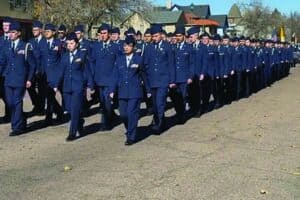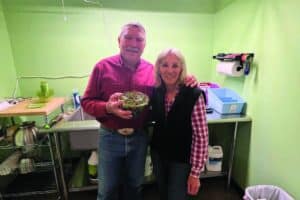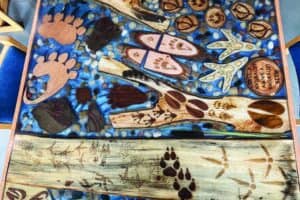The wind howled and rain pelted the crowd during the June ribbon-cutting ceremony for El Paso County’s newest park, but that didn’t detract from the beauty of the sand and clay formations.The Calhan Paint Mines Park is a place to hike, gaze upon a unique environment and think about the past.The history of the sand and clay formations goes back millions of years.Bob Raynolds and Kirk Johnson, geologists from the Denver Museum of Natural History, studied the Paint Mine formations in order to learn more about the entire Denver Basin. They found 55 million years of geologic history recorded in the red, purple, yellow and orange layers of sand and clay. A hard white caprock of sandstone formed on top of the ancient layers preserving both their geologic record and beauty.The white rock gleams in the distance as one approaches the Paint Mines. The white rock is especially important because it is the top part of the Dawson formation – the same coarse-grained gravel and sandstone rock that forms the shallow aquifers in the Denver Basin, which provides a water supply for many residents.Red and purple layers beneath the white rock formed at the beginning of the Eocene, a geologic period ranging from 55 to 37.5 million years ago. The sands are remnants of ancient, weathered soil horizons that point to a time when the climate was much warmer. They also contain fragile gypsum crystals called selenite that can only be formed in a hot, wet climate.Humans first visited the Paint Mines over 9,000 years ago. It’s not hard to imagine Native Americans wandering into the gullies seeking shelter from the fierce winds that blow across the high plains. The valley was a perfect spot to trap bison, antelope and deer. There also was a ready source of petrified wood for making axes and arrowheads, as well as clay.By about 100 A.D., Native Americans discovered the clay was perfect for making pottery. Today archaeologists find many sites throughout the region with potsherds made of materials from the Paint Mines. Native Americans also used the clay to paint themselves and their horses, giving the park its modern-day name.When covered wagons and trains brought white men into the area, they began mining the clays to make bricks. Buildings that remain standing in Denver, Colorado Springs and Pueblo contain bricks made from the clay.The Freeman family, who grazed cattle on the land, most recently owned the Paint Mines. Over the years, they allowed hikers in the mines as long as the livestock were not disturbed. Nick Ordon, former science teacher and principal of Calhan, said he took countless groups of schoolchildren to the mines, and they “had a blast.”El Paso County purchased the site from the Freeman family with funds from the Colorado Lottery. Today, 775 acres have been preserved for El Paso County residents to enjoy, remembering that the formations, artifacts and crystals are protected by law and not to be disturbed.The Evangelical Christian Academy and the Family Campers and RVers donated their time to help construct 2.5 miles of trails through the park.Directions to the park: Take Highway 24 east to Calhan, turn south on Yoder Road to Calhan Highway, turn east on Paint Mine Road and look for the designated parking area.






